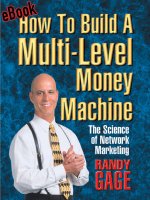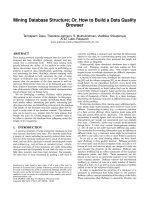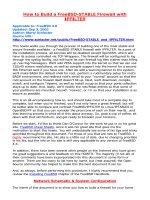How to build a dinosaur
Bạn đang xem bản rút gọn của tài liệu. Xem và tải ngay bản đầy đủ của tài liệu tại đây (2.02 MB, 258 trang )
HOW TO BUILD A
DINOSAUR
EXTINCTION DOESN’T HAVE TO BE FOREVER
JACK HOR NER
AND
JAMES GORMAN
%
DUTTON
HOW TO BUILD A DINOSAUR
HOW TO BUILD A
DINOSAUR
EXTINCTION DOESN’T HAVE TO BE FOREVER
JACK HOR NER
AND
JAMES GORMAN
%
DUTTON
DUTTON
Published by Penguin Group (USA) Inc.
375 Hudson Street, New York, New York 10014, U.S.A.
Penguin Group (Canada), 90 Eglinton Avenue East, Suite 700, Toronto, Ontario M4P 2Y3, Canada (a division of Pearson Penguin Canada Inc.); Penguin Books Ltd, 80 Strand, London WC2R
0RL, England; Penguin Ireland, 25 St Stephen’s Green, Dublin 2, Ireland (a division of Peng uin
Books Ltd); Penguin Group (Australia), 250 Camberwell Road, Camberwell, Victoria 3124,
Australia (a division of Pearson Australia Group Pty Ltd); Penguin Books India Pvt Ltd, 11
Community Centre, Panchsheel Park, New Delhi—110 017, India; Penguin Group (NZ), 67
Apollo Drive, Rosedale, North Shore 0632, New Zealand (a division of Pearson New Zealand
Ltd); Penguin Books (South Africa) (Pty) Ltd, 24 Sturdee Avenue, Rosebank, Johannesburg
2196, South Africa
Penguin Books Ltd, Registered Offices: 80 Strand, London WC2R 0RL, England
Published by Dutton, a member of Penguin Group (USA) Inc.
Copyright © 2009 by John R. Horner and James Gorman
All rights reserved
% REGISTERED TRADEMARK—MARCA REGISTRADA
LIBRARY OF CONGRESS CATALOGING-IN-PUBLICATION DATA
Horner, John R.
How to build a dinosaur : extinction doesn’t have to be forever /
Jack Horner and James Gorman.
p. cm.
Includes index.
ISBN: 1-101-02591-3
1. Evolutionary paleobiology. 2. Dinosaurs—Extinction. I. Gorman, James,
1949– II. Title.
QE721.2.E85H67 2009
567.9—dc22
2008048042
Photo credits: Page 30, courtesy of the author; Page 82, Mary Schweitzer;
Page 195, © J. J. Audubon/VIREO; Pages 216 and 217, © Phil Wilson.
Set in Dante MT
Designed by Daniel Lagin
Without limiting the rights under copyright reserved above, no part of this publication may be
reproduced, stored in or introduced into a retrieval system, or transmitted, in any form, or by
any means (electronic, mechanical, photocopying, recording, or otherwise), without the prior
written permission of both the copyright owner and the above publisher of this book.
The scanning, uploading, and distribution of this book via the Internet or via any other means
without the permission of the publisher is illegal and punishable by law. Please purchase only
authorized electronic editions, and do not participate in or encourage electronic piracy of copyrighted materials. Your support of the author’s rights is appreciated.
While the author has made every effort to provide accurate telephone numbers and Internet
addresses at the time of publication, neither the publisher nor the author assumes any responsibility for errors, or for changes that occur after publication. Further, the publisher does not
have any control over and does not assume any responsibility for author or third-party Web
sites or their content.
For Darwin
CONTENTS
INTRODUCTION
1.
HELL CREEK
TIME, SPACE, AND DIGGING TO THE PAST
2.
85
DINOSAURS AMONG US
CHICKENS AND OTHER COUSINS OF T. REX
5.
57
MOLECULES ARE FOSSILS TOO
BIOLOGICAL SECRETS IN ANCIENT BONES
4.
16
IT’S A GIRL!
A PREGNANCY TEST FOR T. REX
3.
1
114
WHERE BABIES COME FROM
ANCESTORS IN THE EGG
133
CONTENTS
6.
WAG THE BIRD
THE SHRINKING BACKBONE
7.
viii
165
REVERSE EVOLUTION
EXPERIMENTING WITH EXTINCTION
192
APPENDIX: CHICKENOSAURUS SKELETON
215
BIBLIOGRAPHY
219
ACKNOWLEDGMENTS
229
INDEX
231
HOW TO BUILD A DINOSAUR
INTRODUCTION
Nothing is too wonderful to be true if it be consistent with
the laws of nature, and in such things as these, experiment
is the best test of such consistency.
—Michael Faraday
et’s suppose you wanted to pick a moment in the history of
life and play it over again, backward and forward, like a
football play on a highlights DVD, so you could see exactly
how it happened. Rewind. Stop. Play. Rewind frame by frame.
Stop. Play frame by frame.
Stephen Jay Gould, one of the best-known evolutionary biologists of his time, wrote in Wonderful Life, his book on the
weird and wonderful fossils of a rock formation known as the
Burgess Shale, that you can’t go home again, evolutionarily,
unless you want to risk not being here when you come back.
What he was saying was that evolution is a chance business,
L
1
HOW TO BUILD A DINOSAUR
contingent on many influences and events. You can’t rewind it
and run it over and hope to get the same result. The second
time through Homo sapiens might not appear. Primates might
not appear.
That’s evolution on a grand scale, major trends in the history of life that involved mass extinctions and numerous species jockeying for evolutionary position. We can’t rewind that
tape without a planet to toy with. But I’m thinking about a
time machine with a somewhat closer focus, an evolutionary
microscope that could target, say, the first appearance of feathers on dinosaurs, or the evolution of dinosaurs into birds.
This time machine/microscope could zero in on one body
part. For birds we might start small, with a much maligned
body part—the tail. We don’t think about tails much, not at
the high levels of modern evolutionary biology, but they are
more intriguing than you might imagine. They appear and disappear in evolution. They appear and disappear in the growth
of a tadpole. Most primates have tails. Humans and great apes
are exceptions.
The dinosaurs had tails, some quite remarkable. Birds, the
descendants of dinosaurs, now almost universally described
by scientists as avian dinosaurs, do not have tails. They have
tail feathers but not an extended muscular tail complete with
vertebrae and nerves. Some of the first birds had long tails,
and some later birds had short tails. But there is no modern
bird with a tail.
How did that change occur? Is there a way to re-create that
evolutionary change and see how it happened, right down to
the molecules involved in directing, or stopping, tail growth?
2
INTRODUCTION
I think the answer is yes. I think we can rewind the tape of
bird evolution to the point before feathers or a tail emerged, or
teeth disappeared. Then we can watch it run forward, and
then rewind again, and try to play it without the evolutionary
change, reverting to the original process. I’m not suggesting
we can do this on a grand scale, but we can pick a species,
study its growth as an embryo, learn how it develops, and learn
how to change that development.
Then we can experiment with individual embryos, intervening in development in different ways—with no change, with
one change, or several changes. This would be a bit like redoing
Game 6 of the 1986 World Series between the New York Mets
and the Boston Red Sox, when a ground ball ran between first
baseman Bill Buckner’s legs and changed the tide of the series.
We would be doing more than just fiddling with the tape;
we would be redoing the play, with Bill Buckner and all the
players. And the idea would be to determine the precise cause
of the Mets’ joy and Red Sox’ sadness. Was it Buckner’s failing
legs, the speed of the ball, the topography of the field? What
caused him to miss the ball? And when we think we know the
cause, we test our hypothesis. We give him younger legs or
smooth out the field and then we see if in this altered set of
circumstances, he snags the grounder.
That’s impossible to do in baseball. We don’t have a way to
go back in time. We can do it with computer models, of course,
in both baseball and biology. But with current technology and
our current understanding of development and evolution, we
could also do it with a living organism. This ability is largely
the result of a new and thriving field of research that has joined
3
HOW TO BUILD A DINOSAUR
together the study of how an embryo develops with the study
of how evolution occurs. The idea, in simple terms, is that because the shape or form of an animal emerges as it grows from
a fertilized egg to hatching or birth, any evolutionary change
in that shape must be reflected in a change in the way the embryo grows.
For example, in a long-tailed ancient bird embryo the tail
would have started to develop and continued to develop until
the chick hatched with a full tail. The embryos of descendant
species, which hatched with no tails, would have to develop in
a different way. We can observe the embryos of modern birds
as they develop, and if we can pinpoint the moment at which
the tail stops growing, we can figure out exactly what events
occurred at the molecular level to stop tail growth. We can
say—that’s where the change occurred in evolution. And it is
an idea we can test. We can try intervening at that moment in
the embryo’s growth to change the growth and development
signals back to what we believe they were before the tail disappeared in evolution. If we are right, then the long tail should
grow. If we can do this with a tail, we ought to be able to do it
with teeth, feathers, wings, and feet.
The most studied and most available bird for both laboratory and culinary experiments is the chicken. Why couldn’t
we take a chicken embryo and biochemically nudge it this way
and that, until what hatched was not a chicken but a small dinosaur, with teeth, forearms with claws, and a tail? No reason
at all.
We haven’t done it yet. But we are taking the first small
4
INTRODUCTION
steps. This book is about those steps, the path ahead, what we
could learn, and why we should do this experiment.
Hatching a dinosaur from a chicken’s egg may sound like
something that belongs in a movie. It seems very remote from
my specialty, vertebrate paleontology, in particular the study
of dinosaurs. Paleontologists, after all, are the slightly eccentric folks who dig up old bones in sun-drenched badlands and
like to talk too much about skulls and femurs. Well, that may
be true, as far as it goes. But that’s only part of the story. At
heart, every paleontologist is as much Frank Buck as Stephen
Jay Gould.
Frank Buck was a real person who became a hero of movies
and books before and after World War II. He went into the
jungles and remote places of the world and brought back not
fossils, but exotic living animals. He was—and this appealed
to many a small boy—not a hunter who killed his prey, but a
collector of live animals. And his motto, once as well known
as any of today’s catchphrases, was: Bring ’em back alive.
Well, paleontologists may deal with the long dead. But at
the heart of all the digging and preparation of skeletons and
museum displays is the attempt to reconstruct the past, to recreate moments in the history of life. What we would really
love to do, if we could, is bring ’em back alive.
That hasn’t really been possible for the past two centuries as
dinosaur scientists have ventured far into the past, into what is
often called deep time, millions and millions of years ago, retrieving clues and broken pieces of a puzzle that we then try
to solve.
5
HOW TO BUILD A DINOSAUR
Sometimes it’s a literal puzzle, with pieces of fossil skeletons that must be connected and made to fit. Sometimes it’s a
puzzle at another level, trying to put together a long-gone ecological system. Sometimes it is macroscopic—writing the story
of the great trends of evolution, from the seas to land, from the
land to the air, from reptile to bird. Sometimes it is microscopic, digging deep into the tissue of ancient bones to tease
out the physiology of dinosaurs, or the molecular makeup of
fossilized tissue. We describe what dinosaurs were like and
present these ideas in scientific papers and books. We build
skeletons and sculptures of dinosaurs that any museumgoer
can appreciate. We have made robotic dinosaurs for education
and entertainment. We have even helped make movies hew
more closely to the scientific facts. So it’s a natural enough step
to go from building a dinosaur to growing one, from the mechanical to the biological. Or so it seemed, and seems to me,
which is how I became an instigator and a recruiter, looking
for scientists with more expertise than me in the molecular
biology lab to pursue what may seem at first like a cockeyed
idea, to make the ultimate reconstruction of the past, a living
dinosaur.
The first part of any reconstruction is to understand just
what it is you are trying to make. If you’re going to indulge in
biological reverse engineering, you have to take your target
creature apart to see how it works. That’s the bread and butter
of dinosaur scientists. We find fossils, dig them up, date them,
put them in a context with other organisms that lived during
their time. We use the fossilized bones to establish the shape of
the dinosaur. We make educated guesses, some more solid
6
INTRODUCTION
than others, about movement, behavior, social life, parental
involvement with the young.
With modern imaging technologies and computing power,
we look deeper than ever before into the fossils we find. We
can see inside the bones. We use CT scans to make 3-D images of the inside of skulls. We smash up bits of fossils to search
for preserved remnants of muscle tissue, blood vessels, red
blood cells. We use the tools of chemistry and physics to go
deeper yet.
The recent technological changes in how bones are studied
are profound. For most of the last century the study of dinosaurs was primarily a collector’s game. It certainly was not an
experimental science. But that is changing. We can now retrieve ancient biomolecules, like proteins, from fossils tens of
millions of years old. And we can mine the genomes of living
creatures to trace evolutionary history. We can bring the history of life into the laboratory to test our ideas with experiments. And right at the top of the list of the experiments we
can try is the attempt to bring back the characteristics of extinct creatures that have long been lost to us in deep time. That
is how we can build a dinosaur.
We may someday recover bits of dinosaur DNA, but that is
not the route to making a dinosaur. That has already been
tried, in the movies. But it won’t happen in real life. I’m not
putting down the movies. I loved Jurassic Park, not least because I worked on it and the sequels as a technical consultant
to help get the dinosaurs right. And the idea of cloning a dinosaur from DNA recovered from a mosquito preserved in amber that once fed on dinosaurs was a brilliant fiction. It was,
7
HOW TO BUILD A DINOSAUR
however, a fiction that reflected the science of its time, the fascination with DNA and the idea that we would have a complete blueprint of a dinosaur to make one. Now we are actually
much closer to being able to create a dinosaur, without needing to recover ancient DNA.
We can do it because of the nature of evolution, and the way
it builds on itself, adapting old plans to new circumstances, not
inventing new life-forms from scratch. Much of the writing
about dinosaurs in recent times has concentrated on the way
we have been correcting our old mistakes. But mistakes are to
be expected when you are trying to reach back tens of millions
of years. What is amazing, if you stop to think about it, is that
we got the main points right about their shape and structure
right off the bat. How could we do that so easily when you
might think that such ancient animals could have taken any
shape imaginable, or unimaginable?
The answer is that evolution does not allow innovation
without limit. It did not allow the dinosaurs to pop up in any
old shape. They have the same body plan that all other animals
with backbones do. Anyone can see that immediately, with or
without science. Anyone who has seen a deer skeleton, or a
lizard skeleton, or a human skeleton, would recognize the basics in a bunch of T. rex bones dug from the ground. T. rex has
a spine, a skull, ribs, just as an eel or a salmon or a mouse does.
It has hind limbs and forelimbs, just as crocodiles and frogs,
hawks and people do.
Why? Why do animals of such different external shapes
and lives share characteristics so similar that we can immediately recognize the basics of their bone structure? The reason
8
INTRODUCTION
is that shape is not an unlimited smorgasbord from which evolution can pick and choose. All living things are part of a continuum. The shapes of animals evolve over time from earlier
ancestral shapes. Different groups of animals have basic body
plans that themselves evolved from earlier plans.
All vertebrates have backbones. But before that innovation,
they evolved from creatures that all had a front-to-back orientation for eating and elimination. Before that came self-propulsion.
Before that energy metabolism. And so on, back to DNA itself,
which we share with all living things, unless RNA viruses count
as living things. A body plan is an abstract idea—four limbs,
spine, skull, mouth at the front, elimination at the other end—
but it has remained constant and resilient. Mountains have risen
and fallen, seas have appeared and dried up, and continents
themselves have shifted, while the standard four-limb plan, the
tetrapod blueprint, has persisted with minor modifications.
The bones in the hands and arms used to type these words
are almost the same as the bones in Buffalo chicken wings. If
you follow the development of a chicken embryo closely, you
will see five buds at the end of the developing wing, buds that
also appear in the embryos of mice and people. The buds become fingers in a human embryo and claws in a mouse. In a
chicken the five buds on a forelimb will lengthen, shorten, disappear, and be fused to fit into the familiar structure that cries
out to us for hot sauce. The record of such astonishing and persistent continuity of form has been described as the main gift
the fossil record has given to evolutionary biology.
Evolutionary change is added to existing plans. Genetic
blueprints are not thrown out. We don’t have to start from
9
HOW TO BUILD A DINOSAUR
scratch to grow a dinosaur. We don’t have to retrieve ancient
DNA for cloning. Birds are descended from dinosaurs. Actually, they are dinosaurs, and most of the genetic program for
the dinosaur characteristics we want to bring back should still
be available in birds—in fact, in the chicken.
You can see evidence of this continuity in the way an
embryo develops. And chicken embryos, in those perfectly
functional containers, hard-shelled eggs, have been endlessly
studied. Aristotle was the first to record the stages of growth
of a chicken embryo. Other scientists have followed his example, partly because chickens and chicken eggs are so readily available.
You can see easily and clearly with a low-power dissecting
microscope that a tail like a dinosaur’s is well on its way in the
growing chicken embryo before something stops it. The result
is a plump tail stump called the pope’s or parson’s nose (if your
specialty is eating chickens), or the pygostyle (if you are more
given to studying them). The pygostyle is a hodgepodge of different bones, the growth and purpose of which have been redirected, just the kind of jumble that evolution specializes in.
It is a perfect demonstration that evolution does not suggest
intelligence, planning, or purpose, but rather accident and opportunism. Evolution is by definition not revolution. It works
within the system, using what it finds.
One of the hottest fields in science now is evo-devo, for “evolutionary developmental biology.” It has also been called devoevo, or DE, for “developmental evolution.” Whatever the
name, it is the investigation of how evolution proceeds through
10
INTRODUCTION
changes in the growth of embryos. The limb-to-wing transition does not require a complete new set of genes, but rather
changes in the control of a few genes that promote or stop
growth. These genes produce chemicals called growth and
signaling factors that give directions to the cells in a growing
embryo. When they are turned on and off at different times,
that can drastically change the shape of an animal.
It’s a bit like remixing an old recording. Let’s take a band
with a banjo, guitar, and a mandolin playing “She’ll Be Coming ’Round the Mountain.” The original recording features the
banjo, but you want just the guitar and mandolin, so you turn
the banjo tracks way down. If you look at it this way, a bird is
just a new arrangement of an old tune. The dinosaur melody
and the old genetic information are in there, but the sound is
more contemporary. Of course, the better tune right here
might be the old standard, the chicken song, “C-H-I-C-K-E-N,
That Is the Way to Spell Chicken.”
I have a chicken skeleton on my desk at the Museum of the
Rockies. I have for decades kept a chicken skeleton at hand
wherever I have worked, because it looks like a dinosaur, and I
like being around dinosaur skeletons. Sometimes I look at it
and turn it this way and that and think, If I could just grow
these bones a little different, tilt this one way, that another, I’d
have a dinosaur skeleton. Over the past few years I have been
looking at that chicken skeleton more often and more intensely. As I’ve looked at the bones I have started thinking less
about the bones and more about the underlying molecular
processes that caused the bones to grow. And the more I’ve
learned about evo-devo and looked at that chicken skeleton,
11
HOW TO BUILD A DINOSAUR
the more reasonable an idea it has seemed. That skeleton
started out as an embryo, a single cell, dividing and growing,
the cells differentiating into different types. Chemical signals
directed by DNA turned it away from the path of growth that
would lead to a nonavian dinosaur, but it seemed highly likely
that all the raw material, all the genetic information needed to
grow a dinosaur, was in that embryo. How much, I wondered,
would it take to redirect its growth so that it ended up looking
like a dinosaur?
Experimentalists have already caused a chicken to grow
teeth. Other researchers have chemically nudged chicken embryos to develop the different sorts of beaks that the famous
Darwin’s finches display.
Once I got the idea in my head that it could be done, I started
talking to researchers who were truly grounded and fluent in
the language, ideas, and techniques of both paleontology and
molecular biology, like Hans Larsson at McGill. He was already working on what he called experimental atavisms as a
way of understanding evolution. That is, he wanted to prompt
a living creature to develop an ancestral trait.
The short version of the story is that I recruited Hans to
drive the chicken/dinosaur express, at least part of the way.
Hans is not growing a dinosaur, not yet. And none of the embryos in his experiments will hatch. But his research and my
waking dream of having a chicken-sized dinosaur with teeth,
a tail, and forelimbs instead of wings fit well together. So I supported research on getting that chicken embryo to express its
inner tail. He has already discovered aspects of tail growth
that tie this process to the very basic and early directions for
12
INTRODUCTION
the growth of any vertebrate, including humans. So the work
may have unexpected value for some of the most common and
devastating birth defects, those affecting the early growth of
the spinal cord.
Researchers have shown how beaks can be modified by a
change in one gene. If successful, Hans will show how the dinosaur’s tail turned into the chicken’s pygostyle and how to
grow a chicken with a tail instead of a pygostyle. He will also
have laid the groundwork for future research and, perhaps, for
finally hatching that living example of how evolution works.
The scientific rewards of the process of learning how to rewind evolution would be enormous. It would be a remarkable
demonstration of a direct link between molecular changes in
the developmental process and large evolutionary changes in
the shapes of animal bodies. We know quite a lot about the evolution of different forms from the fossil record. And we also
know about specific changes in DNA that cause identifiable
changes in body shape in the laboratory, among fruit flies in particular. But we are just now beginning to link molecular changes
to large changes in the history of life, like the loss of a tail.
A nonavian dinosaur has not yet hatched from a chicken
egg. This book is about how that became a goal I want to pursue, and how that pursuit is continuing, about how I and other
scientists have tried in every way to travel into the past and
bring it to life, how we began with pick and shovel, moved to
CT scans and mass spectrometers, and have now arrived at the
embryology lab.
The story starts with old-fashioned fossil hunting, with the
hunt, the discovery, and the digging, always digging. There
13









